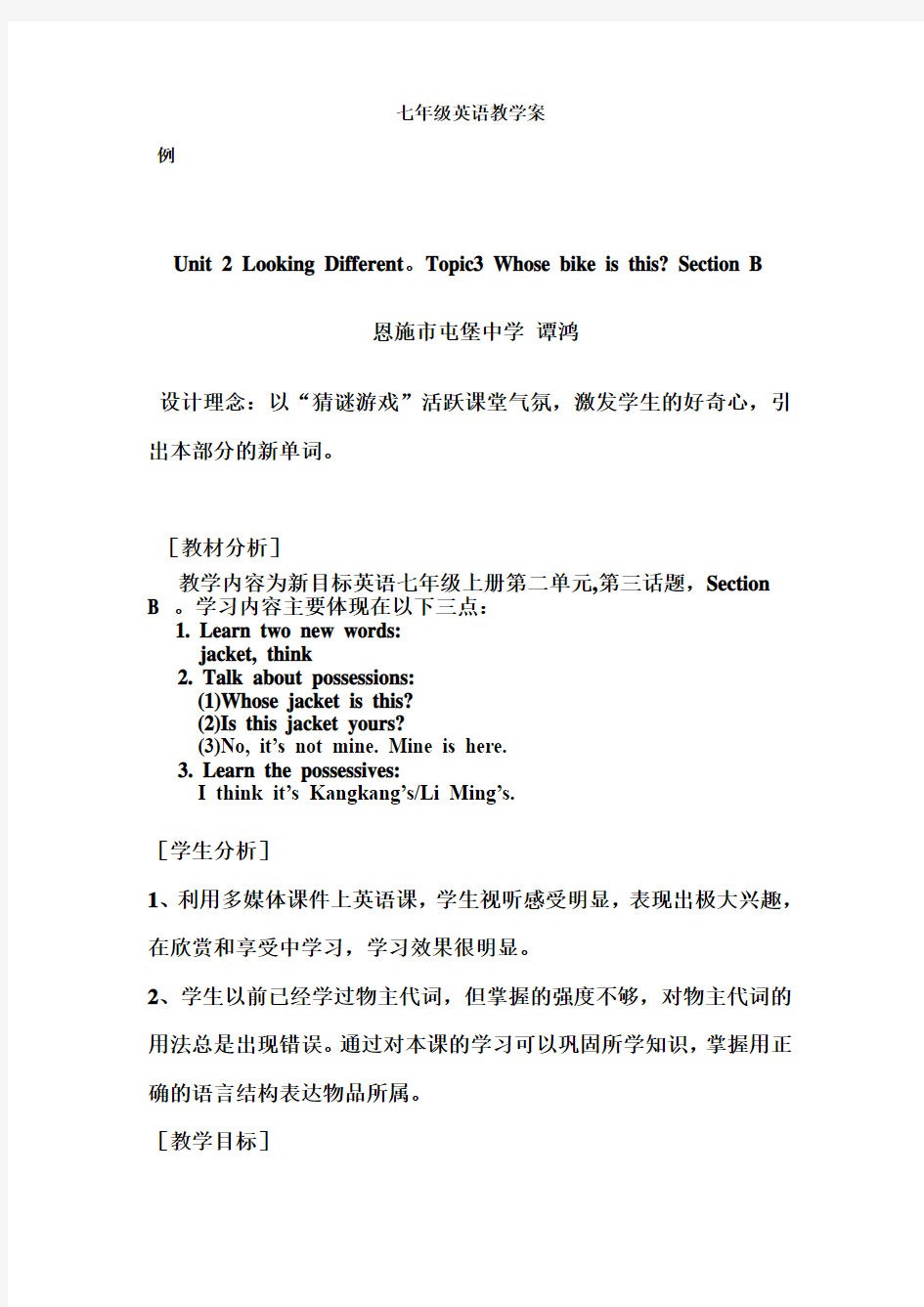

七年级英语教学案
例
Unit 2 Looking Different。Topic3 Whose bike is this? Section B
恩施市屯堡中学谭鸿
设计理念:以“猜谜游戏”活跃课堂气氛,激发学生的好奇心,引出本部分的新单词。
[教材分析]
教学内容为新目标英语七年级上册第二单元,第三话题,Section
B 。学习内容主要体现在以下三点:
1. Learn two new words:
jacket, think
2. Talk about possessions:
(1)Whose jacket is this?
(2)Is this jacket yours?
(3)No, it’s not mine. Mine is here.
3. Learn the possessives:
I think it’s Kangkang’s/Li Ming’s.
[学生分析]
1、利用多媒体课件上英语课,学生视听感受明显,表现出极大兴趣,在欣赏和享受中学习,学习效果很明显。
2、学生以前已经学过物主代词,但掌握的强度不够,对物主代词的用法总是出现错误。通过对本课的学习可以巩固所学知识,掌握用正确的语言结构表达物品所属。
[教学目标]
1、谈论学生感兴趣的话题,指导学生学习有关物品的单词、物品所属的表达及语法知识点。
2、学生根据班级的真实情况,采用“猜谜游戏”、“寻找失主”、“今日之星”的游戏,培养学生的想象力、自信心和合作精神。
3、通过学习本课,增强师生、生生间的相互了解和沟通。
4、培养学生的口头表达能力、阅读理解能力和写作能力。
[教学过程]
Step 1 Review 第一步复习(时间:10分钟)
通过练习或竞赛及游戏的形式,复习上节课所学重难点,自然导入本课生词和句型。
1. (出示小黑板,让学生快速完成“填写形容词性物主代词和名词性
2. (做猜谜游戏。)
(用幻灯片依次展示“a bike”,“apples”,“a shirt”和“knives”的图片。请四个学生上台,面向全班学生,手背到身后握紧。教师在其中一个学生手里放一个糖果,这个学生就被假定为图片中物品的主人。其他学生则通过不断提问把物品的主人找出来。然后换一幅图片,另请四个学生上台,继续游戏。)
T: Now it’s time to play a guessing game. Look at the picture. What’s that?
Ss: It’s a bike.
T: Whose bike is that? We don’t know now. I need four of you to the front. The four students should stand in a row facing to the
class and put their hands behind themselves. I’ll put a candy in
someone’s hand. This one who gets the candy will be the owner
of the bike. What you should do is to guess who has the candy
and find the owner as soon as possible.
(板书句型,并提醒学生注意单、复数的不同以及形容词性物主代词和名词性物主代词的用法。)
(以同样的方式猜测并找出苹果、衬衣及小刀的主人。)
(适时帮助学生用I think it’s/they’re … 回答提问。)
3. (教师事先准备好一个学生的夹克。)
T: W hat’s this in English? Oh, it’s a jacket. S4, is this jacket yours? S4: No, it isn’t. Mine is here.
T: I s this jacket yours, S5? I think it’s yours.
S5: No, it is n’t. I think it’s S6’s.
…
)
Step 2 Presentation 第二步呈现(时间:10分钟)
创设情境,针对本课目标语言进行听、读强化训练,培养学生的语感,形成正确的语音语调。
1. (出示1a图片,让学生看图听录音,回答问题。)
T: Look at the picture, listen to 1a and answer the questions.
(1) What color is
Kangkang’s jacket?
(2) Whose jacket is this?
(再放1a录音,核对答案。)
2. (学生听1a录音并跟读,注意模仿语音语调。)
T: Please listen to 1a and repeat. Pay attention to the pronunciation and intonation.
3. (学生三人一组,应用1a所学,就cat, bag等物品进行替换练习。) T: Practice a conversation according to 1a in groups of three.
Step 3 Consolidation 第三步巩固(时间:8分钟)
通过反复练习,让学生熟悉语言规则,提高学生运用语言的能力。
1. (让学生分组表演对话1a,挑选两组上台表演,并给予表扬和鼓励。) T: Please act out 1a, then I’ll ask two groups to act it out in front of the class.
2. (学生根据1a,完成1b。)
T: Complete the passage according to the conversation in 1a.
(核对答案。)
3. (学生根据1a图片及关键词复述1b。)
Please retell 1b according to the picture in 1a. The key words may help you.
4. (教师出示写有练习题的幻灯片,要求学生根据对话内容填写所缺的单词,并核对答案。)
S1: Excuse me, whose bag is this? S2, is this bag yours?
S2: No, it’s not mine. Mine is here. I think it’s S3’s.
S1: S3, is this bag yours?
S3: No, my bag is blue. This one is red. Please ask S4.
S1: S4, what color is your bag?
S4: It’s red.
S1: Is this bag yours?
S4: Yes, it is mine. Thank you.
S1: You are welcome.
(画线词为学生要填的词。)
Step 4 Practice 第四步练习(时间:10分钟)
通过大量的分层次练习,达到“学中用,用中学”的目的,同时提高学生的听,说,读的能力。
1. (学生听2录音,标出正确顺序。核对答案。完成2。)
T: Listen to the conversation s in 2 and number the pictures. We’ll check the answers together.
2. (看图完成3中的对话,然后分组练习。)
T: Fill in the blanks. Then practice with your partner.
3. (做“物归原主”游戏。)
方法:教师从学生那儿借来一些物品,并使用下列语句:May I have your …? Please give me … 然后把这些物品交给其他若干学生,要求他们在规定的时间内找到物品的主人。在游戏过程中使用Is this your …? Whose … is this? It’s …等句式问答。最快找到物品主人的学生为获胜者。
4. (教师设计一个抢答训练,并记分。完成4。具体操作:教师利用幻灯片依次将笔袋,书,外套展示给学生。学生说对一句得两分,得分最高者为“今日英语之星”。)
T: Look, whose pencil-cases are these?
S1: I think they are Maria’s.
(让学生两人一组练习,并表演对话。)
5. (学生独立完成5,核对答案。两人一组,操练5。)
T: Match the questions with the right answers in 5. Then practice in pairs.
6. (教师出示幻灯片,让学生做选择填空练习。)
T: Please look at these exercises and choose the best answers.
(核对答案。然后学生两人一组互相问答。)
Step 5 Project 第五步综合探究活动(时间:7分钟)
通过编演课本剧“寻找失主”,培养学生的综合语言运用能力、创造
力及小组合作精神。
1. (编排一个短小的课本剧,以“寻找失主”为主题,剧中人物可以是三至五人。)
要求运用下列句式:
Whose … is this?
Is it yours …?
Mine is here.
I think it’s …
What color is …? This one is …
What does … look like?
He/She has …
…
(教师在教室内巡回指导,待学生准备充分之后挑选两组表演出色的学生上台表演,并给予掌声鼓励。)
2. Homework:
(1)每人按要求制作一幅“物主代词卡”。
要求:
①规格:10cm×5cm
②正面写上形容词性物主代词,反面写上相应的名词性物主代词。
③两人一组互相看卡片,说出其汉语及其背面的那个物主代词并拼读。
(2)三人一组,利用自己的物品,用1a中的物主代词表演对话。
Whose bike is this?
Section B
1.—Whose jacket is this?
—Mine is here. I think
it’s …
2.This one is blue.
I think it’s Li Ming’s.
[案例反思]
针对以上所出现的现象,我认为创设情景,营造英语氛围,充分发挥学生学习的主动性是至关重要的.从单词教学到对话独立运用,整个过程处处注意创设情景,营造轻松愉快的课堂氛围;充分发挥道具和肢体动作,进入角色对话.在操练过程中,充分注意到对不同层次的学生提出不同的要求,因材施教。对于基础较差的学生,让好学生做示范,反复操练,这样就避免了会出现好学生越好,差学生越差的现象.帮助他们树立学好英语的信心,创设机会让他们去体验成功的快乐.